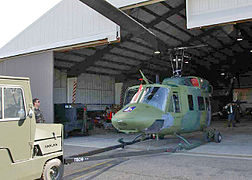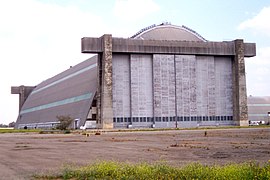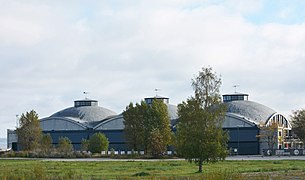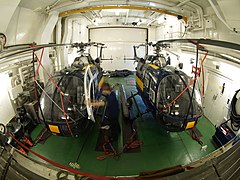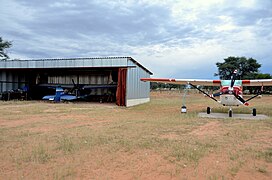A hangar is a closed building structure to hold dav hlau or lub dav hlau. Hangars are built of metal, wood, or concrete. The word hangar comes from Middle French hanghart ("enclosure near a house"), of Germanic origin, from Frankish haigard ("home-enclosure", "fence around a group of houses"), from yam ("home, village, hamlet") and gard ("yard"). gard comes from the Old Norse garðr ("enclosure, garden").
Hangars yog siv los tiv thaiv huab cua, ncaj qha tshav ntuj thiab kho, kho, tsim khoom, sib dhos thiab khaws cov dav hlau.
Cov ntsiab lus
Keeb kwm
| This article needs additional citations for pov thawj. Please help txhim kho kab lus no by ntxiv cov ntawv ceeb toom rau qhov chaw ntseeg tau. Cov khoom siv tsis raug tuaj yeem raug sib tw thiab tshem tawm. Nrhiav qhov chaw: "Hangar" – xov xwm · ntawv xov xwm · phau ntawv · kws tshawb fawb · JSTOR (Lub Yim Hli 2019) (Kawm yuav ua li cas thiab thaum twg thiaj li tshem tawm cov lus no template) |
 The Wright Flyer outside the aircraft's makeshift hangar
The Wright Flyer outside the aircraft's makeshift hangar
The Wright cov kwv tij stored and repaired their aircraft in a wooden hangar constructed in 1902 at Tua Dab Ntxwg Nyoog Hills in North Carolina for their glider. After completing design and construction of the Wright Flyer in Ohio, the brothers returned to Kill Devil Hills only to find their hangar damaged. They repaired the structure and constructed a new workshop while they waited for the Daim ntawv to be shipped.
 Carl Richard Nyberg's hangar for his Flugan (fly) from 1908, Täcka udden in Lidingö, Sweden
Carl Richard Nyberg's hangar for his Flugan (fly) from 1908, Täcka udden in Lidingö, Sweden
Carl Richard Nyberg used a hangar to store his 1908 Flugan (fly) in the early 20th century and in 1909, Louis Bleriot crash-landed on a northern French farm in Les Baraques (between Sangatte and Calais) and rolled his monoplane into the farmer's cattle pen. Bleriot was in a race to be the first man to cross the Lus Askiv Channel in a hnyav dua - dua - huab cua aircraft, and he and set up his headquarters in the unused shed. In Britain, the earliest aircraft hangars were known as dav hlau los, and the oldest survivors of these are at Larkhill, Wiltshire. These were built in 1910 for the Bristol School of Flying and are now Grade II Cov tsev teev npe. British aviation pioneer Alliott Verdon Roe built one of the first aeroplane sheds in 1907 at Brooklands, Surrey and full-size replicas of this and the 1908 Roe biplane are on display at Brooklands Tsev khaws puav pheej.
As aviation became established in Britain before World War I, standard designs of hangar gradually appeared with military types too such as the Bessonneau hangar and the side-opening aeroplane shed of 1913, both of which were soon adopted by the Royal Flying Corps. Examples of the latter survive at Farnborough, Filton and Montrose airfields. During World War I, other standard designs included the RFC General Service Flight Shed and the Admiralty F-Type of 1916, the General Service Shed (featuring the characteristic Belfast-cov roof and built-in various sizes) and the Nplooj ntawv aeroplane shed (1918).
Kev tsim kho
Kev tsim kho hlaukho
Sheds built for rigid airships survive at Moffett Field, California Asmeskas; Akron, Ohio Asmeskas; Weeksville, North Carolina; Lakehurst, New Jersey; Santa Cruz Air Force Base in Brazil; and xa mus los ntawm Cardington, Bedfordshire. Steel rigid airship hangars yog ib co ntawm cov loj tshaj plaws nyob rau hauv lub ntiaj teb no.
Hangar 1, Lakehurst, is located at Naval Air Engineering Chaw nres tsheb Lakehurst (formerly Naval Air Station Lakehurst), New Jersey. The structure was completed in 1921 and is typical of airship hangar designs of World War I. The site is best known for the Hindenburg disaster, when on May 6, 1937, the German airship Hindenburg crashed and burned while landing. Hangar No.1 at Lakehurst was used to build and store the American USS Shenandoah. The hangar also provided service and storage for the airships USS Los Angeles, Akron, Macon, as well as the Graf Zeppelin and the Hindenburg.
The largest hangars ever built include the Goodyear Airdock measuring 1,175x325x211 feet1 and Hangar Ib (Mountain View, California) measuring 1,133 ft 308 ft 198 ft (345 m 94 m 60 m). The Goodyear Airdock, is in Akron, Ohio and the structure was completed on November 25, 1929. The Airdock was used for the construction of the USS Akron and her sister ship, the USS Macon.
Hangar Ib at Moffett Federal Field (formerly Naval Air Station Moffett Field), is located in Roob Saib, California. The structure was completed in 1931. It housed the USS Macon.
Npuag kev tsim kho
Main article: CargoLifter
A hangar for Cargolifter was built at Hom -Briesen Airfield 1,180 ft (360 m) long, 705 ft (215 m) wide and 348 ft (106 m) high and is a free standing steel-dome "barrel-bowl" construction large enough to fit the Eiffel Ntauwd on its side. The company went into kev poob nyiaj txiag and in June 2003, the facilities were sold off and the dav hlau hangar was converted to a 'tropical paradise'-themed indoor holiday resort called Tropical Islands tuaj, uas qhib rau xyoo 2004.
An alternative to the fixed hangar is a portable shelter that can be used for aircraft storage and maintenance. Portable ntaub qauv can be built up to 215 ft (66 m) wide, 100 ft (30 m) high and any length. They are able to accommodate several aircraft and can be increased in size and even relocated when necessary.xav tau kev sau ntawv
Cov qauv thiab qhov ntau thiab tsawg
Hangars xav tau cov qauv tshwj xeeb los tsim. Qhov dav ntawm lub qhov rooj yuav tsum loj; qhov no suav nrog lub dav hlau nkag. Qhov loj dua lub dav hlau yuav tsum tau nthuav tawm, qhov xav tau ntau lub qauv. Raws li qhov ntev ntawm lub hangar, qhov ntau thiab tsawg tuaj yeem muab faib ua li no:
| Loj | Ntev (meter) |
|---|---|
| S | Tsawg dua 30 m |
| M | 30–60 m |
| L | 60–90 m |
| XL | 90–120 m |
| XXL | Ntau tshaj 120 m |
XXL hangars are built for the largest aircraft in the world like the Airbus A380 XWB, Boeing 747 ua and the Antonov 225, uas yog qhov nyuaj tshaj plaws rau erect.4
Kev cai
Hangars feem ntau yog tswj hwm los ntawm cov tsev lis dej num hauv lub teb chaws thiab cheeb tsam thiab cov tshav dav hlau uas lawv nyob. Thaum Lub Yim Hli 2014, Asmeskas FAA tau tshaj tawm txoj cai lij choj ntawm yuav ua li cas lub hangar tuaj yeem siv rau hauv tshav dav hlau uas tau txais tsoomfwv nyiaj txiag. Lub ntsiab lus ntawm kev tso cai ua haujlwm suav nrog kev sib dhos zaum kawg ntawm lub dav hlau.5
Airship hangars
Airship hangars or airship sheds are generally larger than conventional aircraft hangars, particularly in height. Most early airships used hydrogen gas to provide them with sufficient buoyancy for flight, so their hangars had to provide protection from stray sparks to keep the gas from exploding. Hangars that held several airships were at risk from chain-reaction explosions. For this reason, most hangars for hydrogen-based airships were built to house only one or two such craft. During the "Golden Age" of airship travel from 1900, mooring masts and sheds were constructed to build and house airships. The British government built a shed in Karachi for the R101, the Brazilian government built one in Rio de Janeiro, the pt: Hangar do Zeppelin for the German Zeppelins, and the U.S. government constructed Moffett Field, Roob Saib, California and Lakehurst Naval Air Station, Lakehurst, New Jersey.
Hangars nyob rau hauv nkoj
 The helicopter hangar of an Akizuki-chav kawm tus rhuav tshem.
The helicopter hangar of an Akizuki-chav kawm tus rhuav tshem.
Many nkoj nkoj carry aircraft and will often have hangars for storage and maintenance. Such hangars may be situated adjacent to the dav hlau deck on nkoj nkoj, cov neeg rhuav tshem and frigates or underneath the flight deck with lub elevator to lift the aircraft on aircraft nqa and amphibious assault nkoj. Ntawm qee lub nkoj uas qhov chaw luv luv lub hangar thiab lub davhlau ya davhlau sib koom qhov chaw tib yam, nrog lub hangar stowing tam sim ntawd rau kev ua haujlwm davhlau.
Gallery
Hangars can hold tsau - tis dav hlau, rotary- dav hlau ya (nyoob hoom qav taub), and sib dua- dua - nkoj dav hlau.
Hangar No. 2 at the former Marine Corps Air Chaw nres tsheb Tustin is 1,072 ft (327 m) long, 292 ft (89 m) wide and 192 ft (59 m) tall.
Airbus A319 txoj haujlwm tam sim no tau txais los ntawm ADS-B.
Hangars for nkoj hiav txwv of the Imperial Russia Air Force in Tallinn harbor - some of the first reinforced pob zeb structures
A General Dynamics F-16 Sib ntaus sib tua Falcon in front of a Hardened Aircraft Shelter, ib hom tshwj xeeb ntawm hangar
Helicopter hangar of the German research vessel Polarstern
A medium-sized aircraft hangar at Kemble tshav dav hlau, Askiv
Hangar of Iberia Airlines (XXL-150m span) Barcelona tshav dav hlau, Spain
Round concrete hangars at Grimbergen Airfield, Belgium.
Private Hangar on a ua liaj ua teb in Namibia (2017)


